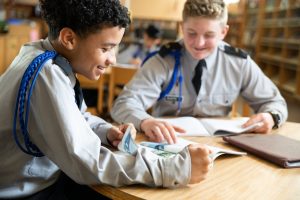 In our guide, we will provide an overview of human brain development, how academic classrooms can be adapted based on five teaching techniques that work best for boys, how to enhance cognitive skills in boys, as well as provide ways to help boys accelerate their emotional and social development.
In our guide, we will provide an overview of human brain development, how academic classrooms can be adapted based on five teaching techniques that work best for boys, how to enhance cognitive skills in boys, as well as provide ways to help boys accelerate their emotional and social development.
While boys can and do excel academically in many types of educational institutions, a school built for the needs of this generation’s boys sets them up for success in the classroom and beyond. Research shows that boys excel more often in a learning environment where learning is tailored specifically toward how boys learn best.
As a case study, we will examine how neuroscience research and specific teaching techniques are being directly employed at Army and Navy Academy, an all-boys boarding school in Carlsbad, California.
Understanding Boys’ Brain Development
Neurological Differences in Boys and Girls
-
Cerebral Cortex – The cerebral cortex is the part of the brain that houses skills that lead to academic success, like memory, attentiveness, language, and more. Boys’ cerebral cortexes are mostly dedicated to spatial functioning, compared to girls’ which are typically focused on verbal ability.
-
Eyesight – Boys’ eyes function best in bright, natural light. By contrast, girls are often better at seeing in dim light and at night.
-
Movement – Boys need to move around to stay alert, while girls often find it easier to sit still for longer periods of time.
-
Competition – Boys tend to thrive on competition, while girls tend to prefer learning environments with collaborative projects.
-
Relational Learning – Boys tend to be relational learners, whereas girls are typically not. This means that boys are more likely to excel in a class where the teacher serves as a mentor in addition to an educator.
Impact on Learning and Behavior
- Problem-Solving – Boys need to exercise executive function skills, including solving complex problems.
- Making Good Choices – Boys need to slow down before making decisions and see the role they play in creating positive and negative situations.
- Understand Consequences – Boys can rewire their brains by learning how to connect impulsive thinking to actual facts and outcomes.
Adapting Classroom Strategies for Boys
In this section of the guide, we will cover five teaching methods employed at Army and Navy Academy that are backed by neuroscience research. If you are someone interested in helping boys learn better, you will find success with these teaching techniques.
- Teaching Technique (Spatial Functioning) – Teachers at the Army and Navy Academy (aka “ANA”) design lesson plans that play into boys’ spatial abilities. One teacher, for example, noticed that students loved playing Minecraft. Instead of seeing it as a video game to play during downtime, he worked with his students to use the game to create a full 3-D map of the campus down to every last detail, including the inside of each building. This was a fun and interactive lesson, using the boys’ spatial abilities to teach concepts like architecture and geography.
- Teaching Technique (Movement) – Rather than long lectures, ANA faculty prepare interactive lessons that encourage movement and alertness. In an English class, for example, students read Dante’s Inferno. Instead of the traditional “calling on a student,” the teacher throws a football to the student selected to answer. The student would then stand up to give his response and throw the ball to another student. The movements involved in catching a ball, standing up, and throwing it to another classmate keep boys alert.
- Teaching Technique (Competition) – Teachers at ANA have found that competition in the classroom can lead to a dramatic jump in engagement. A competition as simple as seeing which team of students can solve a problem the fastest can turn a typical lesson into a very exciting one. In a biology class, for instance, when students were learning about natural selection, the students were split into two teams: spoonbills vs. fork bills, to see which species would come up on top. The element of competition keeps the boys attentive and engaged throughout the lesson and teaches important life lessons like teamwork, problem-solving, and working toward a common goal.
- Teaching Technique (Eyesight) – Since boys typically see best in natural light, many teachers take classroom lessons outdoors. On any given day, you might see students from Spanish class conjugating verbs in chalk on the blacktop or a science class recording nature observations on the front lawn or at the beachfront. This is where the boys’ eyes are working at their best so they’re able to take in the lessons more fully than they might be able to in the classroom. This also ties in to the importance of physical activity; the boys are on their feet for most of these outdoor lessons, keeping their brains active and engaged.
- Teaching Technique (Relational Learning) – After class, teachers hold office hours and lead clubs or coach athletic teams so that students can get to know them outside of the classroom. Boys benefit when they have the opportunity to form relationships with others, so creating these types of interactions is especially important. Because ANA is a boarding school, we provide an additional team of staff to care for our students outside the classroom and off the field. These are our TAC Officers which stands for Trainer, Advisor, and Coach. These adults teach character development lessons and serve as mentors and role models for the students. It’s not uncommon for students to thank their TAC in their high school graduation speech for the role he played in helping them navigate the many life lessons gained at the Academy.
Enhancing Cognitive Skills in Boys
For Critical Thinking and Problem Solving, Edutopia.org recommends:
- Make time for metacognitive reflection.*
- Teach reasoning skills.
- Ask open-ended questions.
- Teach information literacy.
- Provide diverse perspectives.
- Practice makes perfect.
*Metacognition refers to the self reflective process of thinking about how one thinks, processes ideas and learns.
For Memory and Concentration Techniques, Understood.org recommends:
- Add color.
- Employ visualization.
- Take a multisensory approach.
- Make use of patterns.
- Connect experiences.
For Encouraging Creativity and Innovation, Buildingboys.net recommends:
- Motivate them to be curious.
- Encourage them to be creative.
- Let them take risks.
Emotional and Social Development in Boys
For Understanding Emotional Intelligence, Child-Focus.org recommends:
- Model healthy behaviors.
- Encourage communication.
- Teach problem-solving skills.
- Provide opportunities for social interaction.
- Encourage independence.
- Practice empathy.
- Practice mindfulness.
For Promoting Social Skills and Teamwork, LearningLinks.org recommends:
- Encourage eye contact.
- Learn to ask questions.
- Teach them emotions.
- Practice role playing.
- Know a child’s limits.
- Be a good role model.
- Prepare them for higher level social skills.
For Managing Stress and Building Resilience, GrowstrongKC.com recommends:
- Teach them self-care (show, don’t tell!).
- Teach them to listen to their bodies.
- Nurture a positive self-view.
- Make connections.
- Maintain a daily routine.
- Remember to take a break.
- Set goals and work toward them.
- Help them help others.
As you can see, by understanding the key insights from neuroscience research, we can better understand how to teach boys the way they learn best. The long-term benefits of tailored teaching techniques based on neuroscientific research will help boys ignite their passion for learning, improve their cognitive skills, and develop both socially and emotionally.
Learn More.
Questions? If you have a question or would like to schedule a campus tour at our all-boys school, feel free to contact us.


